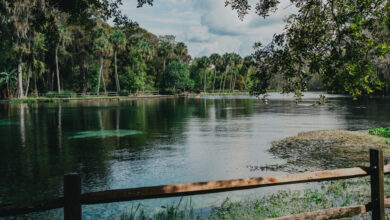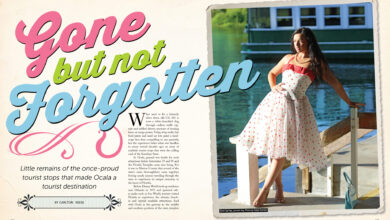Written by: Keith Chartrand
A tan 2005 GMC truck is parked in a driveway just a stone’s throw away from Silver Springs. The 10-year old pick up is brand-spanking new compared to the office building it sits in front of and the building’s contents. A white office door, framed by dark blue stucco, separates three small rooms from the cars on NE 24th Street, a common shortcut to Wal-Mart. Natural light has a small presence in the largest of the three rooms. It slightly illuminates a production studio fixated in the past. There is a Smith Corona typewriter, whose tan and brown plastic frame resembles the wood paneling you’d see on a 1970’s station wagon. Three rows of shelves fill one wall, where brownish-grey circular tins, no more than a quarter of an inch wide, are placed like books in a library. Below the shelves sits various audio and video playback equipment as if being displayed in a history museum. There is an audio reel-to-reel machine, a cassette tape player, a movie projector and a VHS machine. Unlike the rest of the office, the front right corner of the room pops with color. Different shades of blue on the corner wall help illuminate black and white photographs. What was captured in each 8-inch by 10-inch rectangle tells the history of the world-famous Silver Springs. How each image was captured, starting in 1932, tells the history of a local patriarch in the world of photography. Moreover, it shows Bruce Mozert’s desire for and elongated longevity in the world of both photography and life.
The National Center for Health Statistics published a report on mortality in October. Life expectancy rose to 78.8 years, a record high in 2012. Bruce Mozert defies that number. Most 97-year olds don’t go into the office five days a week, but Mozert does – working every bit as hard as a 37-year old.
“Keeping busy is how I do it,” Mozert said. “I’m doing something all the time; printing (photos); thinking of ideas.” Mozert’s bladder reminds him of his age, most often in the middle of the night. When Mozert wakes in the wee hours of the morning, he finds himself unable to fall back asleep. That is when his mind works overtime. “A lot of things come to me then. Sometimes I forget them the next morning and I wish I had written them down.”
It was also in the middle of the night, 74-years ago, that Mozert’s creative thinking led to one of the greatest innovations in the history of photography. The idea came to him, not during a trip to the bathroom, but on a detour on his way to Miami. The young freelance photographer had just finished an assignment – a commercial shoot in St. Augustine. Black Star, the New York photo agency that assigned Mozert his jobs, got wind of a movie being filmed in Silver Springs. They sent their newly hired photog to capture the filming of Tarzan the Ape Man. Mozert would be trekking across, what is today, State Road 40 before heading south to Little Havana.
“It was a single track, only wide enough for one car in one direction,” said Mozert. He went on to say, with a reminiscent grin, “The cars going east had the right-of-way so I had to constantly move over. There were cattle all over the place. Back then if you hit a cow you had to pay for the cow.”
Mozert wasn’t star struck when he arrived. Director W.S. Van Dyke was directing actor Johnny Weissmuller as Tarzan and Maureen O’Sullivan as Jane. What opened Mozert’s eyes in amazement was the clarity of the springs. He took it upon himself to deviate from his original assignment to try something that only two other photographers had ever successfully attempted – taking photographs underwater.
The night of his arrival, Mozert went to work.
“Mr. Ray, the owner of the Springs, let me use the workshop where the glass-bottom boats were worked on,” Mozert recalls. He remembers seeing all kinds of interesting equipment there. His work went on through the night, until three o’clock the following morning.
Sheets of metal, a soldering wire and Plexiglass were all Mozert needed. The same equipment that kept the glass-bottom boats operational, so visitors could see the beauty of the springs, would be the very thing Mozert used to change photography and the perception of the springs forever – being able to bring the springs to everyone and eventually bring everyone to the Springs.
Mozert single-handedly created a casing for his camera with the metal, wire and glass – making it waterproof. With anticipation, to see if his creation worked, Mozert dove in to the crystal clear spring and took a picture of Tarzan swimming behind a log, as well as eleven other never-before taken photographs.
“I took one of the pictures [after developing it] to the Silver Springs public relations office,” said Mozert. “A businessman from MGM studios was up there. He bought [all of them] for $12. I made more copies and sent them to the wire services to get them in newspapers. Underwater pictures had never before been published.”
Alice Adelaide Moser, more commonly known as Zoe Mozert, had been living and working in New York City for years after attending the Philadelphia School of Art. As an illustrator, she painted women in pastel style, using mirrors and cameras to capture her own pose. Moser’s work was renown, appearing on magazine covers and movie posters. It was Moser’s connections in the industry that got her ambitious brother Bruce from behind the wheel of a truck and behind the lens of a camera.
“[Zoe] helped me get a job working along side Victor DePalma, a Life Magazine photographer,” said Mozert. “I did all of De Palma’s processing. We made a small dark room out of the studio where Zoe did her work.” DePalma taught Mozert that the essentials of photography were composition, lighting and background. “[DePalma] also told me to keep my mind concentrated on the subject being shot,” said Mozert. “The goal is to draw the viewer into the picture.”
Within a year of his internship with DePalma, Mozert was out on his own getting paid to take pictures. Bruce wasn’t taking scenic shots of Central Park either. No. “I took chances,” boasted Mozert. These “chances” are what propelled Mozert to success in the industry.
The New York Mirror Newspaper was impressed with his work and commissioned Mozert, who was determined to make a dramatic first impression. He headed for the Williamsburg Bridge, a suspension bridge across the East River that connects lower Manhattan to Brooklyn. Suspended more than 100 feet above the river, Mozert bravely clung to the bridge’s cable to photograph a boat. Mozert knew this daring photo would provide a perspective, an angle, never taken before – ever!
“If you were going to advance, you had to be of a certain caliber and do certain things,” said Mozert. “That job [on the bridge] advanced me fast. I skipped several steps and DePalma got me work from a photo agency. They got me wonderful jobs.”
Mozert may not be able to claim his picture of Tarzan as being the first picture ever taken underwater or published. In 1856, it is recorded that William Thompson lowered his camera into the depths of Weymouth Bay, off the south coast of England, to snap the first underwater picture. In 1893, a French zoologist named Louis Boutan captured a diver wearing the infamous Denayrouze helmet. The photo, which was grainy and cloudy, was eventually published.
However, the technological advances, circumstances and timing of Mozert’s underwater photos at Silver Springs went far beyond what Thompson and Boutan had previously done.
For starters, the water of the springs was so clear. Nothing like the murky settings seen before. The clarity of Mozert’s photos popped off of the paper. Also, Mozert’s subjects were actors and actresses – recognizable and desirable faces that the public longed to see. They took instruction with ease, like true trained professionals, giving Mozert multiple opportunities to capture the best photos possible.
MGM representatives at the Springs not only confirm the importance of Mozert’s now-famous photos, but his reviews and praise expedited the process of getting these pictures published. Movie posters were created quickly. The distribution of news, information and photos via the Associated Press and UPI wire services were Mozert’s greatest resource. Once AP and UPI got wind of Mozert’s accomplishment and had obtained tangible copies of the photos, the entire world would see what he did.
A picture with the dateline “Silver Springs, Florida” was the best advertisement Mr. Ray could ask for. Ray didn’t shell out one dime to have Mozert on site. The only thing it cost him was a few pieces of metal and some Plexiglass. Ray reveled in the amounts of publicity Silver Springs got from Mozert and was overwhelmed how quickly the attention came pouring in. It’s exactly why Ray gave Mozert the job of official photographer of Silver Springs.
Silver Springs was never going to be Hollywood. Yet between the mid 1930s and the late 1960s, if a movie or TV series called for a water scene, more often than not it was filmed at Silver Springs. One of the many spinoffs of the original Tarzan film, Tarzan Finds a Son, was filmed in 1938.
Additionally, many other films used Silver Springs as their setting. In 1952, The Barefoot Mailman, a comedy-adventure film starring Emmy winner Robert Cummings and Terry Moore; and Distant Drums, featuring Gary Cooper as a American solider fighting the hostile Indians of the Everglades, were filmed. The Creature from the Black Lagoon, who was played by Ben Chapman on land and Ricou Browning underwater, was the most recognized film recoded at the Springs. Olympic athlete turned actress Esther Williams teamed with George Sidney in the 1955 film Jupiter’s Darling. The TV series Sea Hunt with Lloyd Bridges was taped from 1957-1961.
On a daily basis, Mozert would capture the behind-the-scenes images of what happened on the set. Currently there are six drawers in his back office, each the same width and height of a card catalog drawer. All six are filled with negatives. Each negative is in its own small envelope labeled either by the actor/actress name or the film name. There are upwards of 3,000 negatives.
“Folks from Tallahassee came down here,” said Mozert. “They looked through what I had and took about 150 pictures.” These pictures are now in the state archive. Bruce follows by saying jovially, “If they have them, they must think they are pretty important.”
Florida’s Division of Library and Information Services raided Mozert’s collection to showcase the development of TV and movies in the state. His underwater picture of Gill Man carrying Ginger Stanley from Creature from the Black Lagoon was one of the 150 pictures taken and now proudly displayed. Others memorialized photos include Gary Cooper sitting campsite holding a rifle, Esther Williams getting her hair done before getting on set and Lloyd Bridges in an aqua suit.
The less serious side of Mozert’s photography came when he wasn’t working on the movie set. To promote the Springs, he created real life situations underwater that had never before been seen or done. It was uniquely popular. For example, Mozert captured a woman, totally submerged, sitting on a beach chair on the bottom of the Springs’ floor, applying suntan lotion. Another unique photo was taken of a man riding a bicycle, again, totally underwater, with a woman on the handlebars. There was also one of a man pushing a lawn mower as if he was cutting the underwater vegetation and one of a beautiful woman shooting an arrow from a bow.
Many people have asked Mozert how in the world he was able to make that arrow shoot straight despite being underwater, competing with the flow of the bubbling spring. The answer is simple. “We didn’t do anything special,” says Mozert. “She just shot it and I clicked at the right time.”
Being deep underwater and staying there long enough for Mozert to get his shot wasn’t something that just anybody could do. “The requirement was,” Mozert explains, “they need to be able to be underwater for 90 seconds.” In actually, two-minutes was ideal. Guys like Lloyd Bridges and the other actors had these puffed out chests. They could hold their breath that long. However, there were times when some couldn’t. Many could only hold their breathe for 30-seconds, probably because they smoked. “Sometimes we had to use the less prettier girl in a shot because the sexier girl couldn’t be down there that long,” chuckled Mozert.
Iconic photographs are taken to make a point – a statement. They influence, inspire and document life. Alfred Eisenstaedt took the famous photo of the sailor kissing the nurse during the New York City parade, celebrating victory in World War II. Cecil W. Stoughton took the photo of Lyndon Johnson being sworn in as president aboard Air Force One, after the death of John F. Kennedy. Jeff Widener took the photo of the lone Chinese demonstrator standing in front of a tank on Tianmen Square.
Perhaps Mozert’s photos weren’t as chilling or as controversial as the aforementioned, but they influenced and inspired a way to forever document life underwater. To this day, Mozert still calls Ocala home. Each day he pulls his GMC truck out of the office driveway and heads home traveling west on State Road 40. When the sun is out, it appears like he is riding off into the sunset; similar to one of the old movies he took photos of so many years ago.






